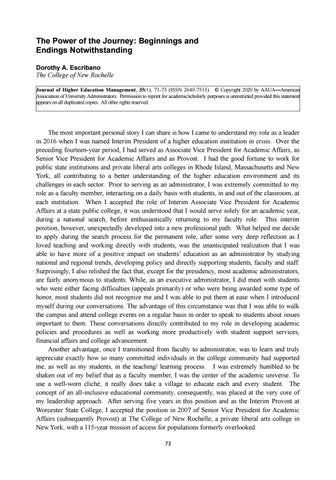The Power of the Journey: Beginnings and Endings Notwithstanding Dorothy A. Escribano
The College of New Rochelle Journal of Higher Education Management, 35(1), 71-73 (ISSN 2640-7515). © Copyright 2020 by AAUA—American Association of University Administrators. Permission to reprint for academic/scholarly purposes is unrestricted provided this statement appears on all duplicated copies. All other rights reserved.
How It Began
The most important personal story I can share is how I came to understand my role as a leader in 2016 when I was named Interim President of a higher education institution in crisis. Over the preceding fourteen-year period, I had served as Associate Vice President for Academic Affairs, as Senior Vice President for Academic Affairs and as Provost. I had the good fortune to work for public state institutions and private liberal arts colleges in Rhode Island, Massachusetts and New York, all contributing to a better understanding of the higher education environment and its challenges in each sector. Prior to serving as an administrator, I was extremely committed to my role as a faculty member, interacting on a daily basis with students, in and out of the classroom, at each institution. When I accepted the role of Interim Associate Vice President for Academic Affairs at a state public college, it was understood that I would serve solely for an academic year, during a national search, before enthusiastically returning to my faculty role. This interim position, however, unexpectedly developed into a new professional path. What helped me decide to apply during the search process for the permanent role, after some very deep reflection as I loved teaching and working directly with students, was the unanticipated realization that I was able to have more of a positive impact on students’ education as an administrator by studying national and regional trends, developing policy and directly supporting students, faculty and staff. Surprisingly, I also relished the fact that, except for the presidency, most academic administrators, are fairly anonymous to students. While, as an executive administrator, I did meet with students who were either facing difficulties (appeals primarily) or who were being awarded some type of honor, most students did not recognize me and I was able to put them at ease when I introduced myself during our conversations. The advantage of this circumstance was that I was able to walk the campus and attend college events on a regular basis in order to speak to students about issues important to them. These conversations directly contributed to my role in developing academic policies and procedures as well as working more productively with student support services, financial affairs and college advancement. Another advantage, once I transitioned from faculty to administrator, was to learn and truly appreciate exactly how so many committed individuals in the college community had supported me, as well as my students, in the teaching/ learning process. I was extremely humbled to be shaken out of my belief that as a faculty member, I was the center of the academic universe. To use a well-worn cliché, it really does take a village to educate each and every student. The concept of an all-inclusive educational community, consequently, was placed at the very core of my leadership approach. After serving five years in this position and as the Interim Provost at Worcester State College, I accepted the position in 2007 of Senior Vice President for Academic Affairs (subsequently Provost) at The College of New Rochelle, a private liberal arts college in New York, with a 115-year mission of access for populations formerly overlooked. 73
